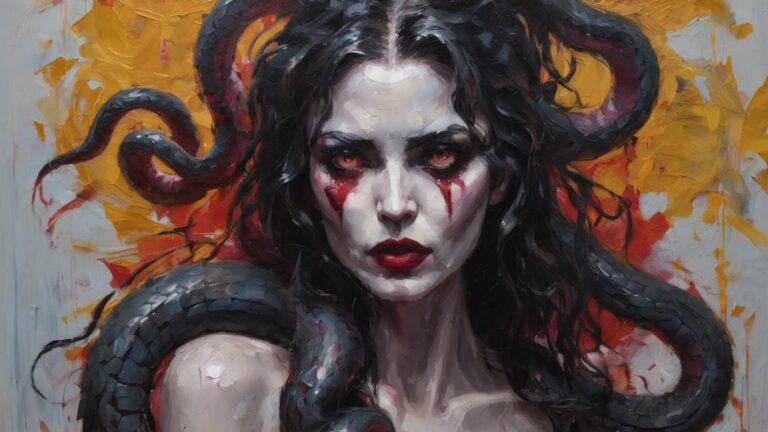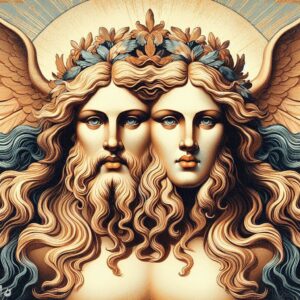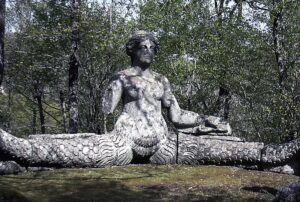Table of Contents
Greek (culture)
Reptilian (attribute)
Cave Dweller (attribute)
Deadly (behaviour)
One of the most well-known stories about Lamia comes from ancient Greek mythology. According to some accounts, Lamia was originally a beautiful queen loved by Zeus. However, after facing the wrath of Hera, Zeus‘ wife, Lamia experienced a tragic fate. In some versions of the myth, Hera either killed Lamia’s children or cursed her to devour her own children. Overwhelmed by grief and guilt, Lamia transformed into a monster that preyed on other people’s children, particularly infants.
In other traditions, Lamia is described as a seductive, vampiric creature who lures and consumes the blood of young men. The concept of Lamia has been adapted and reinterpreted in various ways throughout history and across different cultures.
Lamia was originally Zeus’s lover who hid her in a cave when his wife Hera was by his side. Hera found the cave in Africa where she slept and turned her bottom half into a serpent and killed her children. From this time on, Lamia bore a hatred for all humanity and lured children and men into her cave where she killed them.
Origin
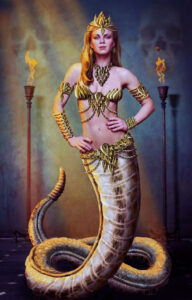
The origin of the Lamia myth can be traced back to ancient Greek mythology. The story of Lamia is associated with a tragic tale involving the queen of Libya, who was loved by Zeus, the king of the gods in Greek mythology.
According to one version of the myth, Lamia was a beautiful queen with whom Zeus had an affair. This angered Hera, Zeus’s wife, and in her jealousy and rage, Hera either killed Lamia’s children or caused Lamia to go mad and kill her own offspring. Overwhelmed with grief and guilt, Lamia transformed into a monster with the ability to devour children, particularly infants.
The earliest known references to Lamia can be found in ancient Greek texts. The poet Callimachus wrote a poem titled “Lamia” in the 3rd century BCE, and it is considered one of the earliest literary works that mentions the mythical creature. Later, the myth of Lamia was further developed and expanded upon by other ancient writers, including Philostratus and Aristophanes.
The concept of Lamia has endured through the centuries, and the myth has been adapted and reinterpreted in various forms in literature, art, and folklore. The character of Lamia has been featured in works by poets such as John Keats and in later literary and cultural references.
Physical Description
The physical description of Lamia can vary depending on the cultural and artistic interpretations of the myth. In ancient Greek mythology, Lamia was often depicted as a beautiful woman who, due to a tragic transformation, became a monstrous creature. The exact details of her monstrous form were not always explicitly described in ancient texts.
Later artistic representations and literary works have depicted Lamia in various ways. Some descriptions emphasize her serpent-like features, associating her with a serpentine lower body or a coiled tail. Other depictions may focus on her more monstrous aspects, such as sharp claws or fangs.
In literature, Lamia has been portrayed as a seductress who uses her beauty to attract and deceive others, particularly men or mothers with infants. This portrayal aligns with the idea of Lamia as a dangerous and malevolent figure, especially in relation to her role in harming or devouring children
Personality
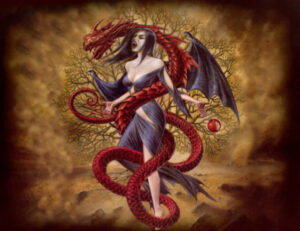
The personality of Lamia, as depicted in mythology and literature, is often characterized by a tragic transformation from a once-beautiful being to a malevolent and vengeful figure. Here are some common traits associated with the personality of Lamia:
Grief and Tragedy: Lamia’s story is rooted in tragedy and grief. In many versions of the myth, she experiences immense sorrow and loss, usually involving the death of her children. This grief becomes a driving force behind her transformation into a monstrous figure.
Vengefulness: Lamia is often portrayed as seeking revenge for the wrongs done to her, particularly by Hera, Zeus’s wife, who is often implicated in the tragic events leading to Lamia’s transformation. This vengeful aspect of Lamia’s personality can manifest in her harmful actions, especially toward children.
Deception and Seduction: In some interpretations, Lamia is portrayed as a seductress who uses her beauty to deceive and lure victims, often young men. Her ability to change her appearance is sometimes emphasized, allowing her to appear attractive before revealing her true, monstrous nature.
Maternal Instinct: Despite her tragic circumstances, Lamia is sometimes depicted as having a maternal instinct, albeit a twisted one. In some versions, she may be driven by a compulsion to harm or consume the offspring of others as a dark reflection of her own lost motherhood.
Loneliness and Isolation: The transformation of Lamia often results in her becoming isolated and estranged from society. Her monstrous form may make her an outcast, contributing to her sense of loneliness and despair.
Special Abilities
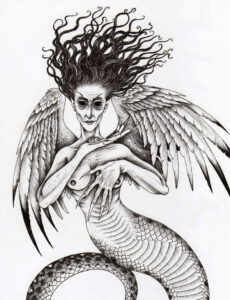
(by Verreaux
Medium: Pencil)
Shape-Shifting: Lamia is often described as having the ability to change her appearance. This shape-shifting ability allows her to transform from a beautiful woman into a monstrous or serpentine form. This trait is sometimes linked to her deceptive nature, enabling her to trick and seduce her victims.
Vampiric Traits: In some interpretations, Lamia exhibits vampiric qualities. This may include a thirst for blood, especially the blood of young children or infants. The vampiric aspect of Lamia’s character can be a central theme in stories that emphasize her predatory nature.
Seduction and Deception: Lamia is often portrayed as a seductress who uses her beauty to attract and deceive her victims. Her ability to captivate others, especially men, plays a role in her stories of betrayal and harm.
Cursing or Hexing: In certain versions of the Lamia myth, she may possess the ability to curse or hex others. This is often linked to her tragic backstory, where she may have been the target of a curse herself, leading to her transformation into a monster.
Immortality or Longevity: Lamia is sometimes associated with immortality or extended longevity. This trait can be tied to her supernatural origins or as a consequence of her transformation. In some stories, she continues to exist for an extended period, perpetuating her grief and vengeful nature.
Mystical Powers: Depending on the narrative, Lamia may be endowed with other mystical powers, such as the ability to control serpents, manipulate dreams, or wield dark magic.
Ralated and similar creatures
Several mythological and folklore creatures share similarities with Lamia or have comparable characteristics. Here are a few examples:
Empusa: In Greek mythology, Empusa is a demonic, shape-shifting creature often depicted as a beautiful woman who transforms into a monster, similar to Lamia. Empusa is said to feed on blood and is associated with seduction and deception.
Gorgons (e.g., Medusa): The Gorgons in Greek mythology, including the most famous one, Medusa, are female creatures with serpent hair and a gaze that can turn people to stone. While not directly equivalent to Lamia, Gorgons share a connection to monstrous women with serpentine features.
Succubus/Incubus: In various mythologies and folklore, succubi are female demons who seduce men, while incubi are their male counterparts who seduce women. These entities are often associated with nocturnal visits and draining life force or vitality from their victims.
Lilith: In Jewish folklore, Lilith is a demon or supernatural being associated with seduction and malevolence. She is sometimes depicted as a night-demon who preys on children and men. Lilith is considered a dark and dangerous figure in mythology.
Sirens: In Greek mythology, Sirens are often depicted as beautiful, singing creatures who lure sailors to their doom with their enchanting voices. While not explicitly monstrous in appearance, Sirens share the theme of using allure and deception to harm or lead astray.
Lamiae in Roman Mythology: In Roman mythology, Lamia refers to a child-devouring monster similar to the Greek Lamia. The Roman version also involves a tragic backstory and association with the devouring of children.
Strix: In Roman and Greek mythology, the Strix is a nocturnal bird-woman associated with dark magic. The Strix is sometimes depicted as a vampiric creature that feeds on the blood of infants.
These creatures often share themes of transformation, seduction, and the consumption of life force or vitality. While not identical, they contribute to the rich tapestry of mythical entities with similar characteristics found in various cultures throughout history.
